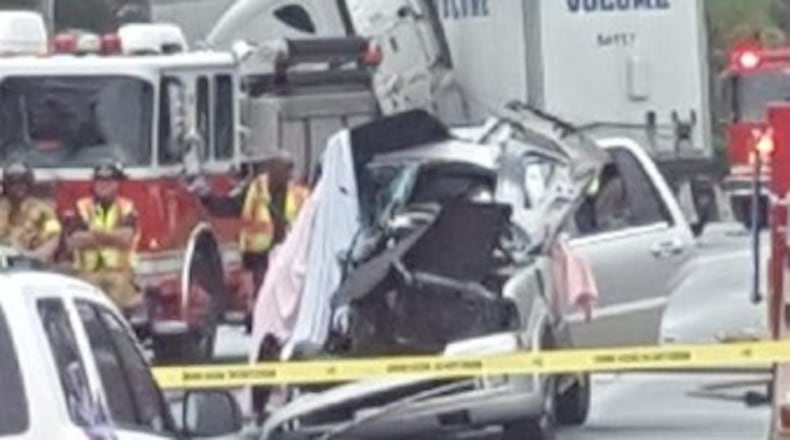Death, especially that of a child, brings grief that can be debilitating in the near term and surface months and years later in unexpected ways.
So the tragedies rippling across Fulton County's Langston Hughes High School, which lost four students in a crash Monday, and Cobb's Lassiter High, which lost two in another, provides an intense emotional challenge for the school systems.
The students are gone, and all the districts can do -- their most important job at this point -- is help the survivors.
“That’s a deep impact on a school,” said Torri Jackson, president of the Georgia School Counselor Association. “You need coverage for everyone, not just the students. We’re talking faculty and staff as well.”
Photos: Langston Hughes High shaken by 4 students’ deaths
Photos: Lassiter High mourns brothers killed in crash
Counselors are in short supply. A 2015 study committee by the Georgia House of Representatives reported one for every 500 students -- half as many as are recommended by the American School Counselor Association.
Georgia recommends 450 students per counselor but some schools have far more. Maria Grovner had 750 on her roster when she was a counselor in a metro Atlanta middle school.
To help the overwhelmed school staff in a crisis, districts typically assemble crisis response teams by pulling in staff from other schools and even tapping community organizations for help. Even then, said Grovner, now at the Georgia Department of Education and in charge of training and support for school counselors and social workers, “there are more students than a crisis team can see.”
Fulton brought in 25 counselors, social workers and psychologists from across the district Tuesday to augment the team of six regularly stationed at Langston Hughes High, which has about 1,900 students.
They decided to set up four “care” rooms, one for each grade level.
Administrators worked the hallways, ensuring that students seeking help found the right place. They’ll meet at the end of each day to determine how large a presence will be needed the following day.
“This is going to be something that’s ongoing given the ripple effect of this event,” said Candace Ford, the school psychologist overseeing Fulton’s response.
Typically in these situations, teachers will announce that the services are available, but officials won’t stop there. They’ll identify relatives and friends in the school and cross-reference class schedules to find students who would have been close to or in regular contact with the deceased.
The loss in Cobb cuts across several schools because the two brothers who died were involved in ROTC and worked with corps members at other schools. One of their instructors had gone with the mom to identify the bodies, then traveled between schools to explain the deaths to other ROTC students. He was so shaken he had to walk away from a press briefing, said Donna Lowry, the Cobb district spokeswoman. On top of all that, the boys' sister, a junior, attends Lassiter. "They have kids really having a tough time with this," Lowry said.
The counseling teams cannot remain on site indefinitely, and some kids don’t step forward seeking help. With graduation approaching, some will carry this burden into the world.
Ford, of Fulton, said her staff will work with community organizations to find services for students who won’t have a school to turn to.
Parents, relatives and friends should be on the watch for signs of lingering trauma, Jackson said. Obvious emotional reactions like sadness and anger can surface weeks, months or years later, along with an instinctive avoidance of places that trigger memories of the dead. And there are subtler signs, such as withdrawal from others, disinterest in favored sports or hobbies, an inability to concentrate on things like school work and even sleep disturbance.
Grovner, with the state education department, said counselors typically mark their calendars to check in with students on dates that could trigger an emotional reaction, such as the birthday of the deceased.
The counselors themselves do not escape unharmed, often suffering from exposure to such intense emotional loss. They know to seek “self care” afterward, possibly from another counselor, said Jackson, who works for the Liberty County School System on the Georgia coast.
It’s a tiny system with about 10,000 students, a tenth the size of Fulton. Yet in her dozen years as a counselor she’s known six students who died. Each affected her deeply.
“I can remember the names and the faces of those I’ve lost,” she said. “You never forget them.”
The National Association of School Psychologists offers this resource to help with the aftermath -- Crisis: Helping Children Cope with Grief and Loss.
Photos: Lassiter High mourns brothers killed in wreck
James Pratt, 18, a senior at Cobb County’s Lassiter High School, and his younger brother, Joe, 14, a freshman, were killed when they hit a school bus carrying special-needs students on April 24, 2017, police said.
Photos: Langston Hughes High mourns students killed in wreck
Four Langston Hughes High School students died when their Lincoln Navigator struck a tractor-trailer on April 24, 2017, police said. A fifth student, Lexus Todd, was hospitalized with leg injuries and bleeding in the brain.
About the Author
Keep Reading
The Latest
Featured


